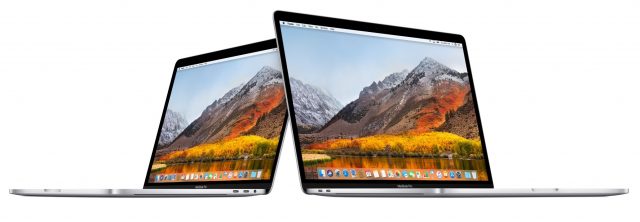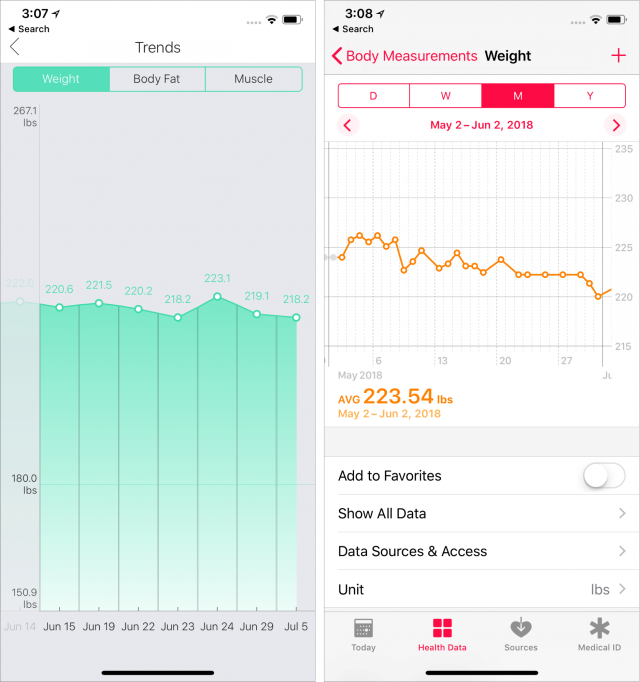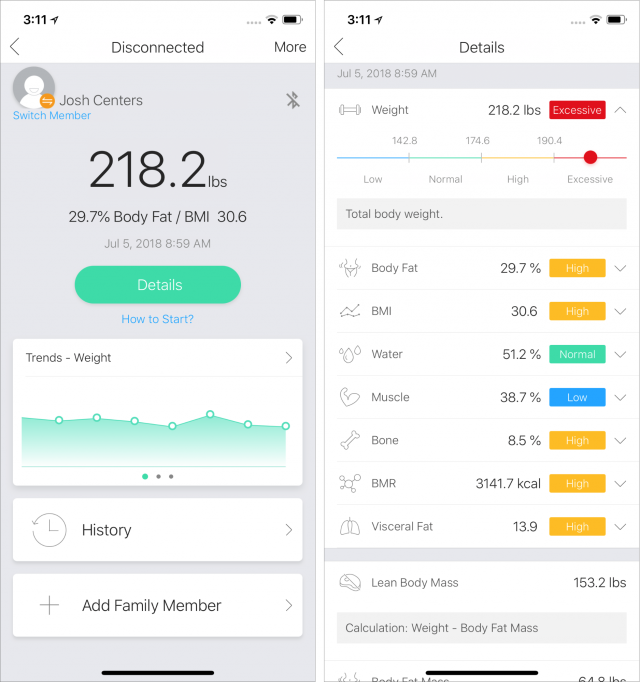#1425: New MacBook Pros, the App Store’s impact after 10 years, Eufy BodySense smart scale
The big news this week is Apple’s release of new MacBook Pros that boast faster performance, a higher RAM ceiling, larger SSD storage, and more—read on for details from Adam Engst. The App Store has turned 10, and while Apple congratulates itself, Adam weighs the pros and cons. Speaking of weighing, Josh Centers engages in some navel-gazing while reviewing the Eufy BodySense smart scale. Notable Mac app releases this week include Security Update 2018-004 (Sierra and El Capitan), iTunes 12.8, Safari 11.1.2, Farrago 1.2, Keyboard Maestro 8.2.2, Luminar 2018 1.3, Bookends 13.1.1, and BBEdit 12.1.5.
Apple Updates MacBook Pros with Faster CPUs, Higher RAM Ceiling, True Tone Display, and T2 Chip
Just in time for the education ordering season, Apple has updated the Touch Bar-equipped MacBook Pro line with a variety of under-the-hood enhancements—8th-generation Intel processors, higher RAM ceilings, and larger SSDs—that make the laptops more powerful, all while retaining current prices. Also new and welcome are True Tone displays, a tweaked butterfly keyboard, and an Apple T2 chip.

The 13-inch MacBook Pro that has only two Thunderbolt 3 ports and function keys in place of the Touch Bar remains unchanged, as do the MacBook and MacBook Air lines.
CPUs
In both the 13- and 15-inch MacBook Pro models, Apple is adding CPU cores. Previously, the 13-inch MacBook Pro offered three different speeds of Intel Core i5 and i7 chips, all of which were dual-core. Now the 13-inch model starts with a 2.3 GHz quad-core Intel Core i5 and offers one jump to a 2.7 GHz quad-core Intel Core i7 (for an additional $300). The new chips also feature faster Turbo Boost rates and 128 MB of performance-enhancing eDRAM (embedded DRAM), twice as much as before.
Similarly, for the 15-inch MacBook Pro, Apple has swapped out quad-core Intel Core i7 processors in favor of base 6-core models running at 2.2 GHz and 2.6 GHz with 9 MB of shared L3 cache. The top-of-the-line 15-inch model now sports a 2.9 GHz Intel Core i9 processor with 12 MB of shared L3 cache. That i9 processor doesn’t come cheap—it’s a $400 premium over the 2.2 GHz i7.
Someone will undoubtedly put these new MacBook Pros through benchmarks soon, but Apple is claiming performance boosts of up to 70 percent for the 15-inch models and up to 100 percent for the 13-inch models.
RAM
A common complaint with the MacBook Pro line concerned its 16 GB RAM ceiling. That maximum remains in place for the 13-inch MacBook Pro, which defaults to 8 GB and can be configured with 16 GB for an extra $200. The new 15-inch models, on the other hand, still ship with 16 GB, but now go up to 32 GB for $400 more.
In addition, while the current 13-inch models and previous 15-inch models rely on 2133 MHz DDR3 RAM, the new 15-inch models use 2400 MHz DDR4 RAM. DDR4 RAM is reportedly faster and uses less power (interestingly, DDR4 memory has been on the market since early 2015, so it has taken quite some time to appear in the Mac world).
Storage
If you cringed slightly at the $400 price increases for the faster CPU and more RAM, hold on to your socks when you look at storage options. The 13-inch MacBook Pro previously topped out with a 1 TB SSD option, but you can now increase the 256 GB default storage to 2 TB ($1400) or stick to 512 GB ($200) or 1 TB ($600).
For the 15-inch model, the maximum is now 4 TB, for which you’ll pay a whopping $3400. Other options include 512 GB ($200), 1 TB ($600), and 2 TB ($1400).
Graphics
The 13-inch MacBook Pro continues to rely on integrated graphics but moves from Intel Iris Plus Graphics 650 to the 655.
The 15-inch models, which can switch back and forth between power-saving integrated graphics and faster discrete graphics, also get minor upgrades. The lower-end configuration of the 15-inch MacBook Pro moves from Intel HD Graphics 630 to the Intel UHD Graphics 630, and from the Radeon Pro 555 with 2 GB of GDDR5 memory to the Radeon Pro 555X with 4 GB of GDDR5 memory.
For more graphics performance, you can opt for a Radeon Pro 560X with 4 GB of GDDR5 memory—it’s only a $100 price bump.
Keyboard, True Tone, and Apple T2
One of the first questions in TidBITS Talk was about the controversial butterfly keyboard, which Apple introduced in 2016 and has revised once already to address frequent failures. Most recently, Apple launched a service program to repair stuck or dead keys for free (see “Apple Announces Service Program for Butterfly-Switch Keyboards,” 25 June 2018). It seems that Apple has again tweaked the butterfly keyboard to make it quieter, although it’s unclear whether that will address the complaints of those who dislike its feel.
True Tone is less controversial. First introduced with the iPad Pro and added to 2017’s iPhone models, True Tone adjusts the white balance of the screen based on ambient light with the goal of making it more comfortable to view the screen in different lighting conditions. For designers looking to match colors precisely, it might be a problem, but in general, we haven’t heard complaints.
Finally, the Apple T2 chip is quite interesting. The successor to the previous models’ T1 chip, it debuted in the iMac Pro and is an embedded control system that manages system features like the Touch Bar, Apple Pay, and more. Ars Technica described it in a review of the iMac Pro. For the MacBook Pro, it facilitates a secure boot feature, encrypts files on the fly, and perhaps most notably, enables Hey Siri so you can talk to your Mac without pressing a key.
Other Specs
Despite the fact that Apple’s battery life estimates of up to 10 hours usage remain the same, the new 13-inch model sports a 58.0-watt-hour battery, up from a 49.2-watt-hour battery in the previous model. Similarly, the 15-inch model now relies on an 83.6-watt-hour battery, up from a 76.0-watt-hour battery in the previous model, but also retains the same battery life estimates. That presumably means that the added performance comes at the cost of higher power usage.
Also new in all the updated models is support for Bluetooth 5.0 in addition to Bluetooth 4.2. That may eventually be more useful than you might think, since Bluetooth 5.0 offers twice the data rate, four times the range, and packets that are eight times larger. The faster data rate and larger packet size should improve throughput and overall performance—we’re hoping to see Bluetooth 5.0 for faster syncing in the next Apple Watch models. But the most important change may be the range. Bluetooth 4.2 is limited to about 50m, but Bluetooth 5.0 should work up to 200m. That’s an unobstructed range, so it will be much less indoors, but it should mean that Bluetooth 5.0 devices will work throughout a house rather than in just one room. The range is achieved by scaling down the data rate.
Most of the other specs in the MacBook Pro models remain the same: four Thunderbolt 3 ports, 802.11ac Wi-Fi, 720p FaceTime camera, stereo speakers, three microphones, and a 3.5mm headphone jack.
Price and Availability
The entry-level 13-inch MacBook Pro starts at $1799 and the 15-inch model at $2399. Apple offers two versions of the 15-inch MacBook Pro, but the only real difference is that one has a 2.2 GHz i7 processor that can be upgraded only to a 2.9 GHz i9, whereas the other has a 2.6 GHz i7 that you can swap out for the same 2.9 GHz i9.
If you’re a college student buying a Mac, you can get one of these new MacBook Pros (or an iPad Pro) with a free pair of Beats headphones in Apple’s 2018 Back to School promotion.
With both the 13- and 15-inch models, you can choose between silver and space gray, and they’re available now on Apple’s online store and in Apple retail stores and independent Apple-authorized resellers.
As almost always seems to be the case, all these updates are welcome, and if you’ve been thinking about buying a MacBook Pro, now’s a good time. If you purchased one of the previous models in the last two weeks, you can return it and get one of the new models for the same price. If you’re just outside the two-week window, you might be able to plead your case with an Apple Store employee in person, but no guarantees.
Pondering the Impact of the App Store at 10
The iOS App Store is celebrating its 10th anniversary. Apple has commemorated the event with a self-congratulatory article, whose tone rankled from the very first sentence:
When Apple introduced the App Store on July 10, 2008 with 500 apps, it ignited a cultural, social and economic phenomenon that changed how people work, play, meet, travel and so much more.
Don’t get me wrong. There’s no question that the App Store has had a significant impact on individuals and developers alike, and the article includes numerous testimonials. There are also stories like this one from Alan Oppenheimer, who went from helping to create AppleTalk and running an Internet service provider to developing what became Art Authority.
The App Store’s numbers are also hugely impressive. Over 500 million people from 155 countries visit the App Store each week, and Apple says it has paid out $100 billion to developers over the past decade. Currently, there are 20 million Apple developers, and the App Store hosts over 2 million apps. (According to Statista, Google Play offers 3.8 billion apps.)
So yes, the App Store has been successful. But it’s a just a store, and one that suffers from poor app discovery and high developer transaction fees. And how much of its success is due purely to the popularity of the iPhone and iPad? (It’s also fair to ask how much of the popularity of the iPhone was driven by the App Store.) Any hardware platform that sells hundreds of millions of devices and has a software development kit will end up with lots of apps.
Also integral to the App Store’s success is Apple’s tight control over distribution and sales. The only way to sell an iOS app outside the App Store or to distribute an app that doesn’t abide by Apple’s guidelines is through Cydia, which requires a jailbroken device. Needless to say, because jailbreaking relies on security vulnerabilities, Apple makes it as hard as possible. The result is that the App Store is an almost complete monopoly for iOS apps, although the upside is a marketplace largely free of apps that abuse user privacy and security.
Apple goes on to claim that “Before 2008, the software industry was dominated by a few large companies.” Obviously, before 2007, there was no iPhone, so this claim must be about desktop computers like the Mac, but it’s still patently untrue. Sure, Microsoft and Adobe were juggernauts back then (and still are), but there were lots of small developers, many of whom created innovative Mac software that we’ve covered in TidBITS for years. It’s also worth noting that Apple far prefers an industry made up of smaller companies who will never pose a threat. Apple doesn’t want iOS and macOS to depend on software like Microsoft Office or Adobe Creative Cloud that can be used just as easily on other platforms.
Apple’s article implies that the App Store is the path to riches. Some small developers have indeed done very well, but the bulk of the App Store payouts go to large companies—Pokémon Go generated $2 billion in 2017 alone. It’s hard to find current information, but in 2011, one survey found that the median revenue from an iOS game was $2400. (That means that half of the games in this survey made more than $2400 and half made less. The average, which was skewed by a few top performers, was over $86,000.) My point is merely that, despite the big numbers Apple throws around, most apps from most developers don’t make much money.
It is true that the App Store removed certain types of friction from software publishing by providing a distribution and payment system. But if that was so important, the companion Mac App Store, which debuted in 2010, should be more dominant than it is. Thanks to Apple’s often draconian technical requirements (particularly related to sandboxing), fussy submission process, and 30% transaction fees, many Mac developers have avoided the Mac App Store entirely, and some high-profile developers have pulled their products. Apple seems to be making changes to woo them back with macOS 10.14 Mojave, but the point stands—when developers have a choice, they don’t always choose the App Store.
Part of my discomfort with the App Store has been related to the limited number of business models that Apple allows. Yes, Apple added in-app purchases in 2009 and enabled subscriptions in all app types in 2016, but the company has never allowed true trial versions, coupon-based discounting, or paid upgrades. Developers have figured out workarounds in some of these cases, but in the end, the App Store is anything but a “free market.” Perhaps the rise of subscriptions is changing this, but for most of the App Store’s existence, Apple’s forced economic models made developers chase new customers rather than serve existing users with upgrades.
Even more philosophically discomfiting has been watching how the App Store drove the prices—and thus perceived value—of software to essentially zero. Because app discovery in the App Store has always been terrible, and there are so few ways to stand out from the many similar apps in any category, developers responded by competing largely on price. Apps that have price tags at all are considered expensive now, and many free apps rely on intrusive and potentially privacy-damaging advertising. Of course, that’s largely following the lead of the Web, where advertising has long been the dominant approach for revenue generation, and where users are becoming increasingly uncomfortable with ad tracking and personalization.
At this point, any criticisms risk sounding like sour grapes. The App Store is a fact of life, and with no competition, substantive changes will be few and far between. But I don’t think we need to glorify what the App Store has achieved or assume that it has necessarily produced the best of all possible worlds. Even without the App Store, the iOS ecosystem may have evolved very similarly—it’s not as though the Mac world has suffered horribly from app distribution outside the Mac App Store.
In the end, I have much less problem praising the iPhone and the iPad, and iOS in general, along with the useful and entertaining apps provided by independent developers and corporate behemoths alike. But extolling the virtues of the App Store? It’s like talking about how great malls are.
Track Your Weight with the Eufy BodySense, an Affordable, HealthKit-Compatible Smart Scale
It seems like everyone has a different method of losing weight, but one thing everyone needs is a consistent, reliable way to measure progress. That includes keeping records so you can see how your weight fluctuates over time.
I used to do this with pen and paper, but digital scales automate the process and are now reasonably priced. Wirecutter’s pick for best overall bathroom scale costs $35, while their pick for the best smart scale, the Eufy BodySense Smart Scale, is only $40.
I’ve been using the Eufy BodySense for three months, and I’ve been pleased with it. I don’t have access to another calibrated scale, so I can’t vouch for its accuracy, but more important is the fact that it’s consistent. If I take my weight a few times in a row, it will give me the same reading each time, as long as I make sure it’s on a hard, flat surface and that my feet are planted firmly on it.
The BodySense is powered by four standard AAA batteries, which have lasted fine for three months of daily usage. The scale can measure weights from 11 to 397 pounds (5 to 180 kg). Like most smart scales, its top is glass, which looks good when clean but tends to accumulate spots.
On its own, the BodySense is a decent scale, if somewhat bare bones. The display between your toes shows only your weight. But with the accompanying EufyLife iOS app (there’s also an Android version), the BodySense can report on your body fat percentage, muscle mass, body mass index, bone density, and more. It also graphs weight, body fat, and muscle mass over time.
These additional measurements are taken by measuring your body’s electrical impedance, so you must weigh yourself with bare feet. Don’t get too caught up in these numbers because this technique isn’t particularly accurate. I’ve found that the measurements are typical for an impedance scale, which can only give a ballpark figure—hydration levels in particular can have a big effect on results. That’s not to say these numbers aren’t useful, but don’t kick yourself if your body fat percentage has increased by 1% from the day before. Instead, look at the longer-term trends. For example, my body fat percentage was consistently around 32% when I started dieting in April, and it’s now regularly reading around 30%, so I know I’m making some progress.
The main downside of the BodySense’s reliance on its app is that, whenever you weigh yourself with the BodySense, you need the EufyLife app open on your iPhone to log results reliably. At the very least, the app needs to have been opened recently, but if you weigh yourself every day, that shouldn’t be a problem.
I learned that the app could work in the background when my four-year-old son stepped on the scale shortly after I stepped off, and the app picked up his weight. Thankfully, the app is smart enough to recognize that his weight is far different than mine, and it asked for verification before recording it. You can set up profiles for different family members on the same iOS device, but it makes more sense for each family member to set up an account on their own device. One drawback to this approach is that it can make syncing take longer. Since the BodySense syncs through Bluetooth, it has to disconnect from the first device before syncing with the second.
Unfortunately, the EufyLife app requires an account, and I’m not sure why. I logged into my account on a spare iPhone, but none of my information carried over. I tried logging into the EufyLife Web site and was told I had to click on a verification email that never arrived.
It might be that biometric data doesn’t get uploaded to Eufy’s servers at all, but it’s impossible to tell. Eufy’s privacy policy seems generally benign, but if you’re worried about the possibility of your weight data being used in unpleasant ways, I recommend avoiding connected scales entirely. Personally, I don’t care about this information that much, because there isn’t much that someone couldn’t guess by looking at me.
My experience with the account means that I don’t have much confidence in the service side of the BodySense. That’s why my favorite part of the EufyLife app is that it syncs with Apple’s HealthKit, so your biometrics are recorded in the Health app and synced with HealthKit-compatible apps like Cronometer, my preferred app to track calories and carbs. The Health app’s charts are more useful than EufyLife’s since they display many more data points at once. (Annoyingly, you can’t zoom in or out on the EufyLife charts.) The EufyLife app can also sync with Fitbit if you use that.

I’ve long been skeptical of smart scales, but I now see the value, at least in terms of basic record keeping. I’m still somewhat dubious of the whizz-bang features likes body fat percentage measurement. And I’d rather have a scale that doesn’t require an Internet connection at all, for privacy reasons. But for the money, the Eufy BodySense is a pretty good scale that eliminates the need to manage data separately.


 Agen Schmitz
No
comments
Agen Schmitz
No
comments
 Josh Centers
29
comments
Josh Centers
29
comments
 Josh Centers
5
comments
Josh Centers
5
comments
 Josh Centers
10
comments
Josh Centers
10
comments